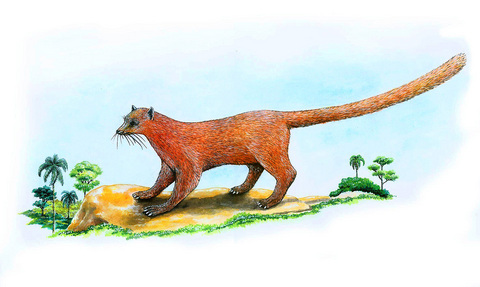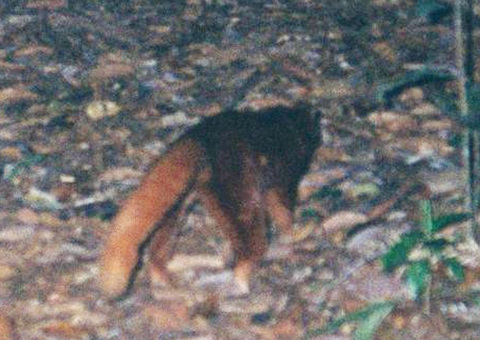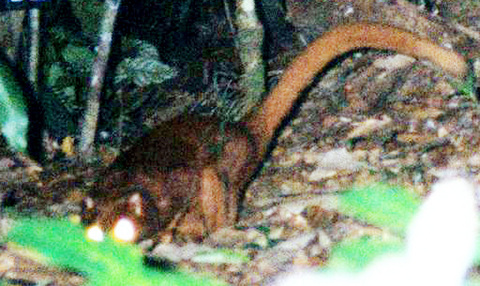The saddest thing about the discovery of a mysterious new mammal on the forest paths of Borneo, is that the creature itself will never know how rare, endangered and exciting to the world's media it is. If the creature, possibly a carnivore not previously known to world science, photographed loping through the darkness, advancing then retreating, its eyes glowing like carriage lamps, had been Colleen McLoughlin putting out the rubbish one night, she would probably have measured the impact of the sighting over the following days at the newsagent's.
But the nameless little beast scampering through the Kalimantan leafmould is unselfconscious about its rarity and feels neither the loneliness nor the isolation which the human world has projected onto it. It just wanted to vanish back into the obscurity from which it was plucked by a World Wide Fund for Nature paparazzo. Relentlessly, one by one, under the banner of protecting the world's wide places, scientists and conserva-tionists are stripping the mystery from these very places by exposing the last unknown mammals.
The existence of what may, or may not, be the latest in a string of new mammals to have been discovered in the last decade was announced in Jakarta last week.

As with many of the previous discoveries, the evidence is, at least at first, indirect -- not the animal itself, captured or seen by a scientist, but two blurry photographs showing, first, a skinny scurrier like a wingless bat with a long fat tail, its muzzle obscured by a leaf, and second, the same creature from behind, with haunches like a monkey and a tail like a well-fed ginger tom.
If past discoveries, such as the Vietnamese otter-civet or the Borneo ferret-badger are a guide, the newbie may come to be known as the cat-dog-fox-monkey-lemur. Then again, the head of the team which discovered it goes by the name of Stephen Wulffraat, so it could, in theory, end up being named after him.
Dr Wulffraat's mobile in Indonesia wasn't working when we tried to call and his fellow mammal-hunters were, in the main, all deep in far wooded places where telecommunications are only a rumor.

Ginette Hemley of the World Wide Fund for Nature, which along with the Wildlife Conservation Society (WCS) has been the main organization backing the scientists who have discovered new mammals, was cautious about the new creature's identity.
"This is potentially a new species," she said. "It has not been confirmed. Doing that will require physical evidence we do not yet have."
The WWF's next stage is to catch one.

PHOTOS: AGENCIES
If there appears to be a degree of urgency in the WWF's mammal- hunting team, it's because time is not on their side. Earlier this year the Indonesian authorities, with the backing of a Chinese bank, announced a multi-billion-dollar plan to plant oil palms in the high mountain forests where the mystery beast lives.
The WWF is sceptical about the project -- oil palms do not grow well at high altitude and there are other areas of Borneo which would appear to be more suitable. The organization suspects a grab attempt for the old-growth timber on the high ridges.
"We're not opposed to an oil palm plantation being developed, as long as it's done in a way that is not going to harm biodiversity," Hemley says.
Incredibly, the Borneo cat-dog-fox-monkey-lemur may be the third previously unknown mammal discovered this year. In a hunter's market in central Laos, a WCS researcher, Robert Timmins, came across a short-legged rodent with a hairy tail and a long snout, as if it started out as a rat, toyed with guinea pigness, and ended up as a squirrel. In this case, "previously unknown" is strictly a culturally relative term. The animal was on sale along with some vegetables, and was well enough known by local Laotians to have a name: the kha-nyou.
Several years previously Timmins discovered a new species of striped rabbit in the same region.
"Sceptics might say that if we are still discovering such amazing new animals then why are people worried about wildlife loss; but, of course, it is an indication of how little we know and a window on to what we could be losing without ever knowing," he said at the time of the kha-nyou encounter.
The notable mammal discoveries of the last decade have been made not by Indiana Jones-style mammal-hunters but by scientists who were not necessarily looking for what they found. Timmins, for instance, was working on an anti-poaching program in Laos when he came across the kha-nyou.
The discovery of this year's third new mammal, the kibunji or Highland Mangabey, a black-faced monkey with a punky quiff which lives in Tanzania, was made independently by two groups of scientists who only became aware of each other's work when they met in a bar in Dar es Salaam and began drinking together.
Tim Davenport, a British
scientist working with WCS, said yesterday that since his photographs of the monkey were published in Science, he and his collaborators had obtained a specimen of the animal -- a monkey killed by a Tanzanian farmer during a crop raid -- and was subjecting it to DNA analysis to disprove early questions over whether it really was a new species.
"There's this assumption that Africa is fairly well known, but it's surprising how little is," he said. "And the places where the interesting things are yet to be found tend to be these remote mountain ranges."
Davenport acknowledged that "discovered for science" would be a more accurate phrase than "discovered," since a monkey which raided village vegetable gardens and had a local name had clearly been known to locals for thousands of years.
He and his team first heard about the kibunji during a routine survey of village life and hunting in the areas on the fringe of the wild country they were surveying -- a standard technique to enrich scientific knowledge of an area.
"We started hearing about this animal," Davenport said. "This area has a lot of spirit animals and we were trying to work out which is a real animal and which is a spirit animal, which is very difficult. At first we thought the kibunji was a spirit animal and it turned out to be real. Now I take the possibility of other spirit animals turning out be to be real more seriously."
One such possibility, yet to be discovered or proved fictitious, is the Rongwe tiger.
"It's some sort of striped animal, and we haven't come across anything more than the description. Whether it's a striped hyena or aardwolf way out of its range, or whether it's a spirit animal, or a new species, we can't be sure. But finding these things is often the thing that gets us out of the tent in the morning," Davenport said.

One of the most important gripes that Taiwanese have about the Democratic Progressive Party (DPP) is that it has failed to deliver concretely on higher wages, housing prices and other bread-and-butter issues. The parallel complaint is that the DPP cares only about glamor issues, such as removing markers of Chinese Nationalist Party (KMT) colonialism by renaming them, or what the KMT codes as “de-Sinification.” Once again, as a critical election looms, the DPP is presenting evidence for that charge. The KMT was quick to jump on the recent proposal of the Ministry of the Interior (MOI) to rename roads that symbolize

On the evening of June 1, Control Yuan Secretary-General Lee Chun-yi (李俊俋) apologized and resigned in disgrace. His crime was instructing his driver to use a Control Yuan vehicle to transport his dog to a pet grooming salon. The Control Yuan is the government branch that investigates, audits and impeaches government officials for, among other things, misuse of government funds, so his misuse of a government vehicle was highly inappropriate. If this story were told to anyone living in the golden era of swaggering gangsters, flashy nouveau riche businessmen, and corrupt “black gold” politics of the 1980s and 1990s, they would have laughed.

It was just before 6am on a sunny November morning and I could hardly contain my excitement as I arrived at the wharf where I would catch the boat to one of Penghu’s most difficult-to-access islands, a trip that had been on my list for nearly a decade. Little did I know, my dream would soon be crushed. Unsure about which boat was heading to Huayu (花嶼), I found someone who appeared to be a local and asked if this was the right place to wait. “Oh, the boat to Huayu’s been canceled today,” she told me. I couldn’t believe my ears. Surely,

When Lisa, 20, laces into her ultra-high heels for her shift at a strip club in Ukraine’s Kharkiv, she knows that aside from dancing, she will have to comfort traumatized soldiers. Since Russia’s 2022 invasion, exhausted troops are the main clientele of the Flash Dancers club in the center of the northeastern city, just 20 kilometers from Russian forces. For some customers, it provides an “escape” from the war, said Valerya Zavatska — a 25-year-old law graduate who runs the club with her mother, an ex-dancer. But many are not there just for the show. They “want to talk about what hurts,” she